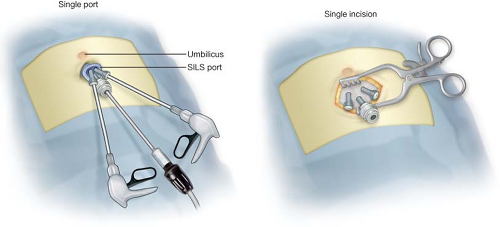Single Access Laparoscopic Hernia Repairs
Laura Dacks
Shawn Tsuda
Introduction
In the last decade, surgery has quickly evolved toward less invasive methods. Laparoscopic surgery has continued to be on the forefront for many general surgical procedures due to shorter hospital stay, less pain, and reduced complications. The development and mastery of minimally invasive methods has piqued interest among surgeons and industry toward innovative methods beyond traditional laparoscopy.
Laparoscopic surgery through a single access site is a minimally invasive surgical technique either through a single incision with multiple instruments inserted into the abdomen via separate trocars or through a multi-channel access port (Fig. 37.1). The procedure is then performed with the same steps as the conventional laparoscopic method. Inherent challenges through this technique would include decreased triangulation, instrument crowding or “sword fighting,” and poorer visualization. Several articles have been published recently focusing on trials and outcomes of laparoscopic single incision surgery for ventral, incisional, and inguinal hernia repairs (Table 37.1). The focus of this chapter is to familiarize surgeons with the most updated techniques of single access laparoscopic surgery (SALS) hernia repairs.
Indications and contraindications are essentially identical to those of the standard laparoscopic approaches.
SALS Totally Extraperitoneal (TEP) Inguinal Hernia Repair
Indications:
Bilateral hernias
Recurrent hernias
Unilateral hernias in young, active patients
Table 37.1 Compilation of Single-Site Laparoscopic Hernia Repair Research | ||||||||||||||||||||||||||||||||||||||||||||||||||||||||||||||||||||||||||||||||||||||||||||||||||||||||||||||||
|---|---|---|---|---|---|---|---|---|---|---|---|---|---|---|---|---|---|---|---|---|---|---|---|---|---|---|---|---|---|---|---|---|---|---|---|---|---|---|---|---|---|---|---|---|---|---|---|---|---|---|---|---|---|---|---|---|---|---|---|---|---|---|---|---|---|---|---|---|---|---|---|---|---|---|---|---|---|---|---|---|---|---|---|---|---|---|---|---|---|---|---|---|---|---|---|---|---|---|---|---|---|---|---|---|---|---|---|---|---|---|---|---|
|




